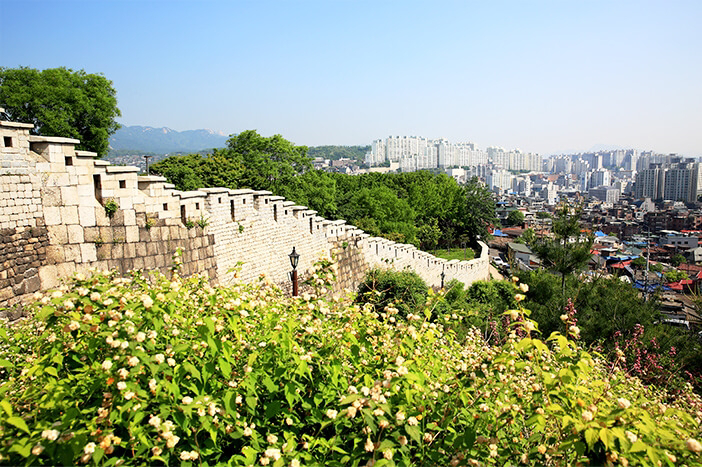Let's Travel and Follow the Traces of History & Culture, Hanyangdoseong when you are on vacation to South Korea
Hanyangdoseong, Seoul City Walls, The perfect season for sightseeing is back. With so many people out and about, try something different by making your walks meaningful. If you're in Seoul, an excursion along Hanyangdoseong, or the Seoul City Walls, is a must! With over 600 years of history, the Seoul City Walls are sure to make your sightseeing memorable.
The Seoul City Walls were built to provide protection to Seoul, formerly known as Hanyang, from outside intruders. This 18.6 kilometer long wall runs along four mountain ridges: Mount Inwangsan, Mount Baegaksan, Mount Naksan, and Mount Namsan. This wall used to be called Hanyangseonggwak (Seoul Fort Wall), but its name was officially changed to Hanyangdoeseong (Seoul City Wall) in July 2011.
There are a total of six different tours available, each with its own charm.
Four trails follow the main mountains:
Baegaksan Mountain Trail, Naksan Mountain Trail, Namsan Mountain Trail, and Inwangsan Mountain Trail; the other two pass through the two major city gates: the Sungnyemun Gate Pass and the Heunginjimun Gate Trail.
Seoul City Wall Structure:
• City Walls: The City Walls were built during three different periods under the reigns of King Taejo, King Sejong, and King Sukjong.
• Fort Gate: Fort Gate consists of four main gates located in the four cardinal directions and four additional gates between the main gates. Known as Sadaemun (Four Great Gates), the main gates consist of Dongdaemun Gate (Heunginjimun) in the east, Seodaemun Gate (Donuimun) in the west, Sungnyemun Gate (Namdaemun) in the south and Sukjeongmun Gate (Bukdaemun) in the north. The four additional gates, referred to as the Sasomun (Four Minor Gates), consist of the southwest Souimun Gate, the northwest Changuimun Gate, the northeast Honghwamun Gate, and the southeast Gwanghuimun Gate.
• Ongseong: Fortress built in front of Heunginjimun Gate for the double protection of the gate.
• Chiseong: A barrier wall that adds extra protection between Heunginjimun Gate and Gwanghuimun. An impromptu square lookout point gives an added advantage against enemies.
• Gokseong: Lookout points built in the Inwangsan and Baegaksan Mountains to strengthen defenses to the west and north.Bongsudae: Beacon stations used as a method of communication by lighting fires at night and providing smoke signals during the day. Currently, the beacon station on Namsan Mountain is the only one that has been restored.
• Sumun: A water gate that controls the flow of water between Heunginjimun Gate and Gwanghuimun Gate on the wall. Two water gates can be seen at Ogansunmun Gate on Cheonggyecheon Stream and Igansumun Gate near Dongdaemun History & Culture Park.
If this is your first time walking one of the Seoul City Wall trails, a good start is the Naksan Mountain Trail. With a mix of trails, mountain slopes and alleyways, this trail offers the perfect mix of what other trails offer beginners. At the starting point at Hyehwamun Gate, there is the Hanyangdoseong Exhibition & Visitors Center where visitors can get trail maps, pamphlets, and an art catalog. Pamphlets about the Seoul City Walls are available in English, Japanese, and Chinese.
The main sights you might see while walking the Naksan Mountain Trail are Jangsu Village, Ihwa Village, and Seoul City Wall Museum. Jangsu Village located under Naksan Park along the City Wall was originally a slum village formed after the Korean War. Now with the average age of the population above 60 years, the name Jangsu Village, which when translated means Longevity Village, was given. As you go further down this path, you will find Ihwa Village. Known for its artistic beauty, Ihwa Village offers 32 attractions, including galleries, museums, cafes, shops, and more. Towards the end of the walk, you can visit the Seoul City Wall Museum to learn about the 600-year-old history of this wall and its value as a cultural heritage.
Source : https://visitkorea.or.id/article/mengikuti-jejak-sejarah-budaya-hanyangdoseong







Komentar
Posting Komentar